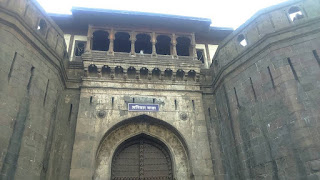SA Site Cover: Shaniwar Wada, Pune by Rakshanda Thakur
When we hear the name Shaniwar Wada the first thing that comes to our mind is the movie Bajirao Mastani and the majestic structure it portrayed, but sadly, it's not what we imagine it to be except some ruins that stand witness to a glorious past. A fire in 1827 that lasted for 15 days destroyed the fort. Before going to the fort I read a little about it and thus I was prepared to see fort in a hopeless condition, but really it wasn't so.
 The entrance to the fort was the Dilli Darwaza, which was intact and relatively in a very good shape, the huge iron door which was built to stand almost anything did what it was meant to do and survived the fire. As soon as I entered the huge iron gate, the inside of the gate the situation changed and the sorry state of the monument was revealed, with the fresco almost fading and the wall plaster falling off. There was a ticket booth or two, I can't seem to remember considering I had been there almost a month ago. When I turned towards the main complex, I expected a half burnt structure, but apart from some column base, platform remains and cannons nothing had survived the fire. The next thing that caught my eye was an intricate water system, with various baths and reservoirs and it really makes one wonder about the importance the Peshwas gave to water because these structures take up a lot of area of the fort and was truly advanced.
The entrance to the fort was the Dilli Darwaza, which was intact and relatively in a very good shape, the huge iron door which was built to stand almost anything did what it was meant to do and survived the fire. As soon as I entered the huge iron gate, the inside of the gate the situation changed and the sorry state of the monument was revealed, with the fresco almost fading and the wall plaster falling off. There was a ticket booth or two, I can't seem to remember considering I had been there almost a month ago. When I turned towards the main complex, I expected a half burnt structure, but apart from some column base, platform remains and cannons nothing had survived the fire. The next thing that caught my eye was an intricate water system, with various baths and reservoirs and it really makes one wonder about the importance the Peshwas gave to water because these structures take up a lot of area of the fort and was truly advanced.
As I moved ahead, the next thing I saw was a brick reconstruction of the stone wall, it wasn't done properly to say the least. A flight of stairs led to the top where some locals told me about a secret passage that led to a river where the Peshwa went for daily prayers. From the top a moat was visible on one side and the office of ASI on the other hand and a load of garbage just next to it, it was definitely shocking, but apart from it the view was breathtaking, if you spend some time looking at the remains of the buildings and the fountains you can almost imagine it standing in all its entirety. The whole experience can be described as a bittersweet one because most of the monument is lost but the remains still tell the story.




Comments
Post a Comment